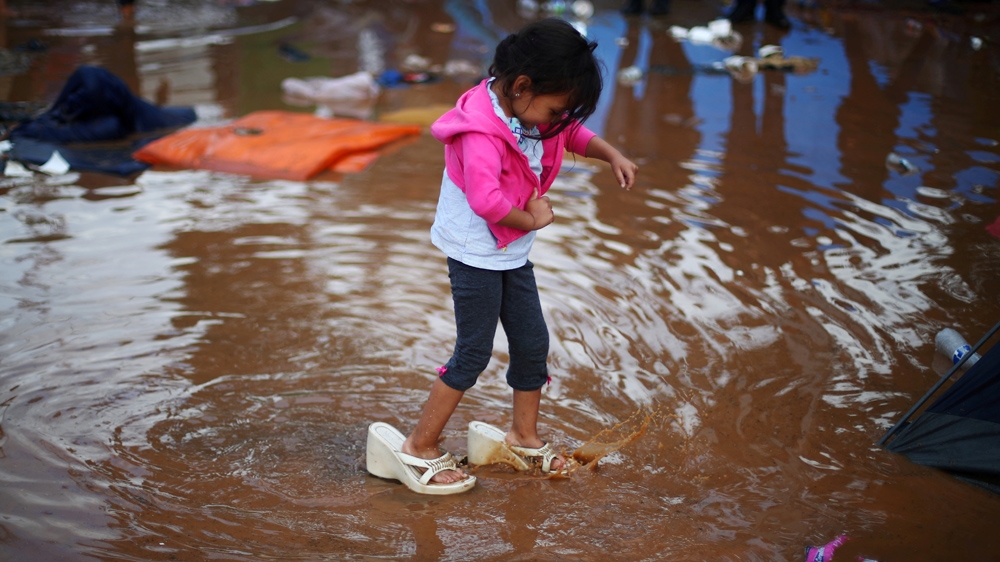
Tijuana, Mexico – As heavy downpours Thursday night flooded the already unsanitary encampment in Tijuana’s northern side where thousands of Central American asylum seekers are being housed, authorities began moving small groups to a new government-run indoor shelter, 20km east of the US-Mexico border.
A total of 700 out of the 6,000 people sheltered at the Benito Juarez sports complex were transported in buses to the new facility.
Buses arrived on Friday morning to transport others, but many expressed scepticism due to the distance the new shelter is from the border.
The rain had turned most of the camp to mud, flooded tents and forced some migrants and refugees to move out of the shelter and onto neighbouring streets where concrete floors made for better sleeping ground.
Living conditions for migrants and refugees are getting worse and wait times for the asylum process are increasingly drawn-out, exasperating Tijuana officials and migrants.
Mirna Contreras was sitting in her tent waiting out the rain on Thursday afternoon. She said she was sad because she didn’t have enough money to rent a room in a local hotel.
“My tent is slowly flooding. It’s really cold at night and I have a bad cold,” she told Al Jazeera.
|
Rain brings misery to caravan migrants camped in Tijuana |
Children walked barefoot through the mud and puddles that gathered in the eastern part of the camp that was originally a baseball field. On Thursday, UNICEF said it was concerned about the nutrition, education and health of the migrant and refugee children.
Unsustainable situation
Tijuana’s Government Secretary Leopoldo Guerrero confirmed the new shelter is spacious enough to house all of the migrants and refugees. But he said the city government is struggling to meet the need for resources including clothes, medicine and food.
The government expects about 4,000 more migrants to arrive in the city in the coming months.
“Tijuana needs the federal government to step in because the current situation isn’t sustainable. We need the federal government to take over the total control of the migrant shelters, including costs,” he told Al Jazeera.
Guerrero said the city spends about $27,119 each day on food, water, clothes and services for migrants and refugees.
The initial group of migrants and refugees who left Honduras more than a month ago arrived in Tijuana in mid-November. Thousands more from Honduras, El Salvador, Guatemala and Mexico have joined subsequent groups.
Many say they are fleeing violence, extreme poverty and political persecution.
Humanitarian crisis
In late November, Tijuana mayor Juan Manuel Gastelum declared the situation a humanitarian crisis and asked the United Nations for aid to help the city deal with the influx of people wishing to apply for asylum in the United States.
Rights groups accused US President Donald Trump of creating the crisis at the border by taking extreme measures against the migrants and refugees, including sending thousands of US troops to the border.
On Friday, US officials said the number of troops would be cut from 5,600 to 4,000, but the deployment may be extended through the end of January, Reuters news agency reported.
Many accuse the US government of stalling the number of asylum applications it accepts, an allegation officials deny.
The new shelter in eastern Tijuana will be run by the Mexican federal immigration agency.
While the Tijuana government feels the financial pressure of maintaining the shelters, migrants and refugees are growing weary of the living conditions and wait times for asylum processing.
Migrants and refugees, with the help of aid groups, are managing their own informal numbering system that has kept track of more than 5,000 asylum seekers to date. Those at the bottom of the list expect to wait at least two months before getting a chance to file their asylum application with US authorities.
 |
| UNICEF have raised concerns about the nutrition, education and health of the children in the camp [Hannah McKay/Reuters] |
Nusli Antunez arrived to the shelter six days ago with her husband and, although she is hopeful she can secure asylum, she wants to get to work in Tijuana.
“We want to get out of here, rent a room and work,” she said.
Antunez was planning on going to a job fair organised for migrants and refugees by Mexico‘s Ministry of Labour.
She has asthma and although she admits that many migrants and refugees have to stay in the shelter because they can’t afford to rent a room, she doesn’t want to.
“Just look at the conditions we live in,” she said.
Meanwhile on Thursday, more than a dozen migrant women announced plans to go on a hunger strike to pressure Mexican and US authorities to speed up the processing of asylum claims.
When the group tried to walk towards the pedestrian border crossing where they planned on carrying out the strike, they were stopped by Mexican federal police that cited security concerns after a protest Sunday resulted in US border patrol agents throwing tear gas at migrants and refugees, including children, and a five-hour border shutdown.
As of Friday morning, 10 people, three migrants and seven human rights defenders are said to be on hunger strike near the pedestrian crossing known as the Chaparral.












